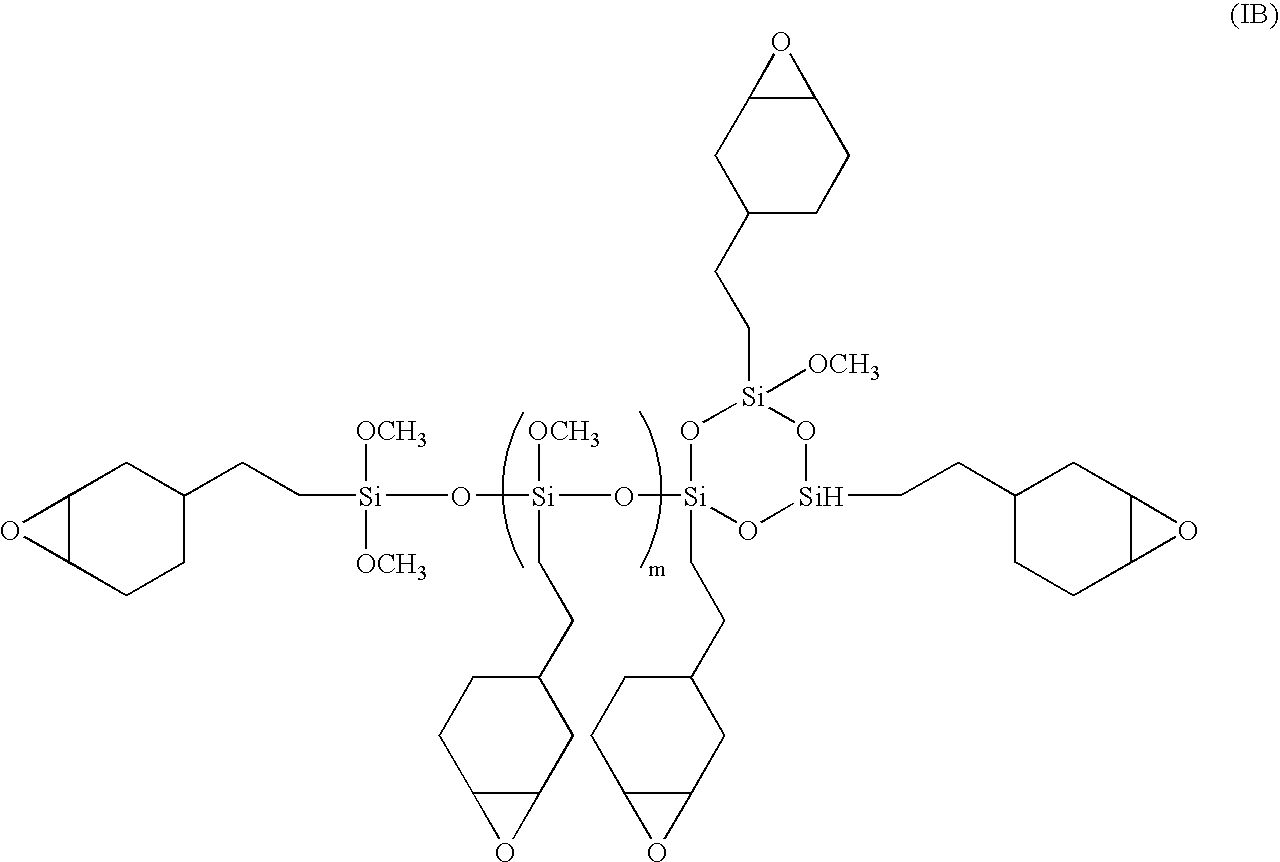Solventless, non-polluting radiation curable coatings
a technology of radiation curable coating and solventless siloxane, which is applied in the direction of coatings, transportation and packaging, synthetic resin layered products, etc., can solve the problems of affecting the application of the coating, and affecting the effect of the coating performan
- Summary
- Abstract
- Description
- Claims
- Application Information
AI Technical Summary
Benefits of technology
Problems solved by technology
Method used
Image
Examples
example 1
E-Beam Cure
[0066] Formulations containing the following components were prepared, cured, and tested:
Formulation1A1B1CComponentParts by Weight42214540—PC-1000454040PC-200351010Vikoflex 9010——40Capa316 / 4101101010Silane A-187222PC-2505 (50%)888
[0067]
Formulation1A1B1CSubstrateAL 36R 36-1AL36R 36-1AL36R 36-1AppearanceFish EyeNoneNoneNoneNoneNoneNoneColorClearClearClearClearClearClearCure (after E-DryDryDryDryDryDrybeam)Methyl ethyl ketone (MEK) (double rub) (ASTM D 5402-93)After 7 days at50+50+50+50+50+50+roomtemperatureAfter Postbake50+50+50+50+50+50+Adhesion Test (ASTM D 3359 Cross Hatch)After 7 days atPassPassPassPassPassPassroomtemperatureT Bend Test (ASTM D 522-88)After 7 days atPassPassPassPassPassPassroom(4T)(4T)(4T)(4T)(3T)(3T)temperature
example 2
E-Beam Cure
[0068] Formulations containing the following components were prepared, cured, and tested:
Formulation2A2BParts byComponentWeight42214040PC-10004040PC-2003108Hycar CTBN1012(1300 × 31)Silane A18722Irganox 10350.40.4PC-250588(50%)
[0069]
Formulation2A2BSubstrateAL 36R 36-1AL 36R 36-1AppearanceFish eyeNoneNoneNoneNoneClarityClearClearClearClearCure (after E-DryDryDryDrybeam)Methyl ethyl ketone (MEK) (double rub) (ASTM D 5402-93)After 7 days at50+50+50+50+room temperatureAfter Postbake50+50+50+50+Adhesion Test (ASTM D3359 Cross Hatch)After 7 days atPassPassPassPassroom temperature1T Bend Test (ASTM D 522-88)After 7 days atPass (3T)Pass (3T)Pass (2-3T)Pass (2-3T)room temperature
example 3
E-Beam Cure
[0070] Formulations containing the following components were prepared, cured, and tested:
Formulation3A3B3CComponentParts by WeightAraldite——456084 / 4221(20 / 80)42214040—PC-1000404045PC-200310510Poly bd 605E10——Hycar CTB—20—(2000 × 162)Irganox 10350.40.4—Silane A-187222PC-2505 (50%)886
[0071]
Formulation3A3B3CSubstrateAL 36R 36-1AL36R 36-1AL36R 36-1AppearanceFish EyeNoneNoneNoneNoneNoneNoneColorClearClearClearClearClearClearCure (afterDryDryDryDryDryDryE-beam)Methyl ethyl ketone (MEK) (double rub) (ASTM D 5402-93)After 7 days50+50+50+50+50+50+at roomtemperatureAfter50+50+50+50+50+50+PostbakeAdhesion Test (ASTM D 3359 Cross Hatch)After 7 daysPassPassPassPassPassPassat roomtemperatureT Bend Test (ASTM D 522-88)After 7 daysPassPass (4T)Pass (4T)PassPassPassat room(4T)(4T)(3T)(3T)temperature
PUM
| Property | Measurement | Unit |
|---|---|---|
| temperature | aaaaa | aaaaa |
| particle sizes | aaaaa | aaaaa |
| wt. % | aaaaa | aaaaa |
Abstract
Description
Claims
Application Information
 Login to View More
Login to View More - R&D
- Intellectual Property
- Life Sciences
- Materials
- Tech Scout
- Unparalleled Data Quality
- Higher Quality Content
- 60% Fewer Hallucinations
Browse by: Latest US Patents, China's latest patents, Technical Efficacy Thesaurus, Application Domain, Technology Topic, Popular Technical Reports.
© 2025 PatSnap. All rights reserved.Legal|Privacy policy|Modern Slavery Act Transparency Statement|Sitemap|About US| Contact US: help@patsnap.com



